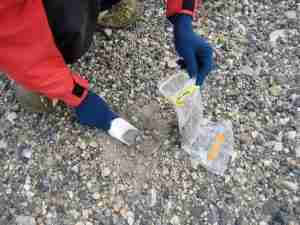We can attend your location and provide a sample retrieval service, or samples can be packaged and sent to us for testing in an accredited laboratory
EMBM provides soil sampling, analysis, testing and waste classification services for clients across sectors and at any stage of the development, construction or waste management process.
You can choose from two levels of service – lab testing on its own, or a full sampling, testing and reporting service. Simply choose whether you would prefer us to either:
- Attend any location nationwide, providing sample collection and full chain of custody documentation; or
- Courier the correct sample containers to your location, with return postage to our lab, arranged on your behalf
Analysis and testing of the samples are undertaken in an accredited laboratory. Standard turnaround times for testing are 10 days, but results can be available in 5, 3 or as little as 1 day if required.
Upon completion of the soil tests, we will issue an interpretive report explaining the significance of the results, as well the laboratory certificate of analysis, which may be requested by regulators such as the local planning authority or Environment Agency.
Complete the quote request form on this page, and our team will be in touch shortly to establish your full requirements and provide you with a quote for sampling and testing costs.

Soil Sampling and Contamination Testing Requirements
Soil testing is often required within the development process, usually as part of a contaminated land survey, water pipeline risk assessment, phase 2 site investigation or remediation verification report. A testing and analysis report is also generally required where excavated soils are to be reused on-site, disposed of off-site (such as to a landfill), or moved between sites. All waste soil should be handled in line with the waste duty of care requirements.
Depending on the local planning authority, contamination testing may even be requested on topsoil originating from a greenfield site or manufactured to approved standards. Any testing for ground contamination should be designed to enable the refinement of a conceptual site model.
Waste Classification Testing & Compliance

Classification as either hazardous (contaminated), or non-hazardous waste is also required for the material being disposed of off-site. As landfill costs for hazardous waste are significantly higher than for uncontaminated waste, it will often make commercial sense to develop a statistical sampling plan which allows more detailed waste characterisation and segregation of hazardous and non-hazardous materials.
Waste classification is carried out in compliance with government guidance. All waste soil should be handled in line with the Waste Duty of Care Code of Practice.
Soil Testing Suites – Laboratory Analysis
A range of sample testing suites is available ranging from single substances that may be known or suspected to be present, to suites of contaminants associated with specific industries and land uses. We can provide any combination of these to meet your specific requirements or that of the local authority. Environmental testing suites can include analysis of soil, leachate and/or water samples, as required.
- Standard Suite: Arsenic (As), boron (B), cadmium (Cd), chromium (Cr), hexavalent chromium (CrVI), copper (Cu), cyanide, mercury (Hg), nickel (Ni), lead (Pb), selenium (Se), zinc (Zn) sulphate, sulphide, total petroleum hydrocarbons (TPHs – speciated: 3 bands), polycyclic aromatic hydrocarbons (PAHs – speciated), benzene, ethylbenzene, toluene, xylene (BTEX) and phenols.
- Extended Suite – As above, plus: beryllium (Be), barium (Ba), vanadium (V), TPH Criteria Working Group (TPH-CWG – aromatic/aliphatic speciation: 16 bands), and poly-chlorinated bihenyls (PCBs).
Additionally, we can provide analyses for any combination of the above elements or compounds, as well as the substances listed below.
- Asbestos Screening and Asbestos Quantification
- Additional metals: aluminium (Al), antimony (Sb), bismuth (Bi), cobalt (Co), iron (Fe), manganese (Mn), molybdenum (Mo), phosphorus (P), silicon (Si), silver (Ag), strontium (Sr), tellurium (Te) thallium (Tl), titanium (Ti)
- Speciated metals: e.g. hexavalent chromium, elemental, inorganic or organic mercury, tributyl and triphenyl tin, tetraethyl/tetramethyl lead
- Leachate analysis
- Water soluble sulphate (BRE 365)
- Chlorinated solvents: trichloroethylene (TCE), 1,1,1- trichloroethane (1,1,1- TCA), perchloroethene (PCE), * dichloroethene (DCE), vinyl chloride.
- Dioxins
- Perfluorinated substances (PFAS/PFCs): PFOS, PFOA, PFHXS,
- Pesticides: Aldrin, Chlordane, Chlorpyrifos, DDT, Dicofol (Kelthane),
- Dieldrin, Endosulfans, Endrin, Heptachlor, Hexachlorobenzene,?Lindane, Mirex, Toxaphene
- Bacteria and pathogens
